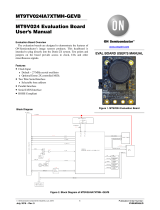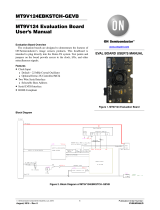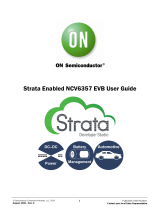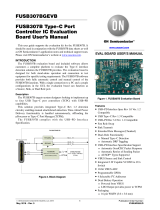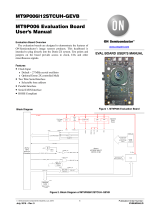
© Semiconductor Components Industries, LLC, 2015
September, 2015 − Rev. 0 1Publication Order Number:
EVBUM2310/D
AGB1N0CS-GEVK
Demo 3 Evaluation Board
User's Manual
Demo 3 Evaluation Board Overview
The Demo 3 Baseboard is used to connect to headboards and
interface with a host PC in order to demonstrate the features of
ON Semiconductor’s image sensor products.
Features
•High-Bandwidth USB 3.0 Interface
•Altera Arria II GX FPGA
•HDMI® Transmitter
•1GB Memory Buffer
•Up to 4-Lane MIPI and HiSPi Interfaces
•CCP and Parallel Interfaces
•I2C Control Unit
Block Diagram
Figure 2. Block Diagram of AGB1N0CS−GEVK
FPGA
5V from USB3
Connector
Digital Video
Interface HDMI
HDMI
connector
USB3
connector
Power
distribution
Frame
buffer
memory
DRAM
I2C
Headboard
connector
I2C
Cypress
FX3
32bit parallel
interface
I2C
MIPI/HiSpi x4,
parallel interface
Headboard
power
switch
Headboard power
I2C
EPROM
www.onsemi.com
EVAL BOARD USER’S MANUAL
Figure 1. AGB1N0CS Evaluation Board
Bottom View
Top View

AGB1N0CS−GEVK
www.onsemi.com
3
Demo 3 Baseboard Function Overview
The Demo 3’s FPGA, Altera’s EP2AGX45DF25C4N,
provides an interface between ON Semiconductor imaging
sensors and the Cypress FX3 USB 3.0 controller. An
external SPI EPROM contains the programming file for the
FPGA. The EPROM is configurable using the FX3 SPI
master interface. The FPGA has a memory controller block
that controls data from the on-board DDR3 SDRAM.
Figure 5. FPGA Block Diagram
Video Rcvrs:
MIPI (4Lane)
HiSpi (4Lane)
CCP (1Lane)
Parallel
DDR3 Memory
Controller
DDR3 SDRAM
(64Mx16)
HDMI
FX3 Interface
Video
Format
Generator
128128
16
Data
Ctl
Ctl
Ctl
32
36
Data
Data
Demo3 FPGA Block
Diagram
I2C
Interface
Formatter
FPGA Frame Buffer
The 1Gb frame buffer using a 64Mbx16 matches data
rates between the sensor and FX3 interfaces. It is sized to
buffer 3 frames of a 20-Megapixel sensor. There is
a triple-buffer to help minimize frame loss. The frame buffer
has two principal operating modes that support either
self-timed operation or direct interface to the FX3 at HDMI
video output of 720p 60 or 1080p 60 frame rates. The frame
buffer controller runs at 150 MHz FPGA core clock with
peak available bandwidth at 750-Megapixels/second, peak
input bandwidth of 400-Megapixels/second, and peak
output bandwidth of 200-Megapixels/second. The frame
buffer can be configured to operate as a frame capture
device, with the entire buffer filled prior to sending data to
the FX3 interface.
Receivers and Data Rates
The FPGA receives data through MIPI, HiSPi, CCP, and
parallel interfaces. Each of these receiver blocks has an
output FIFO that moves data from the receiver clock to the
150 MHz FPGA core clock.
MIPI Receiver:
The MIPI receiver handles 4 lanes of data at a maximum
data rate of 768 Mbps/lane. The signal pairs use both
single-ended and differential signaling with accordance to
the MIPI Alliance Specification for D−PHY v.1.00.00.
HiSPi Receiver:
The HiSPi receiver supports high-speed transmission of
image sensor data, operating at 1 Gbps per data lane. It is
a unidirectional differential serial interface with four data
lanes and one DDR clock lane. It supports Streaming−S,
Streaming−SP, and Packetized SP protocols that conform to
the HiSPi protocol specification v.1.50.00.
CCP Receiver:
The CCP receiver is a single-lane data interface that
supports 8-, 10-, or 12-bit raw data. It operates with
a maximum serial data rate of at least 640 Mbps. The
receiver conforms to the SMIA CCP2 1.0 specification.
Parallel Receiver:
The parallel receiver allows asynchronous switching
between driven and high-Z under pin or register control. The
receiver supports 10 or 12 bits of data, running at a pixel rate
of at least 125 MHz.
HDMI Transmitter
The HDMI transmitter utilizes the ADV7526 chip by
Analog Devices to transmit HDMI 34-bit data to the output
port. The HDMI interface supports the HDMI 1.4 standard
with 12-bit deep color. It supports RGB and YCbCr digital
video input. The I2C device address is 0x72 and accesses
registers inside the HDMI transmitter block.

AGB1N0CS−GEVK
www.onsemi.com
4
FX3 USB 3.0 Interface
The Cypress FX3 has a 32-bit data interface that is
transceived to the differential I/O pins on the
transmitters/receivers of the FPGA. The maximum data rate
of the interface is 5 Gb/s.
I2C Control Bus
The I2C control bus supports 32-bit wide GPIF II data bus
and supports 14 configurable control pins. The control bus
supports bus frequencies of 100 kHz, 400 kHz, and 1 MHz.
Operational mode control is done through software
configuration using the I2C interface from the controller.
The I2C HDMI chip address is 0x72, and clock generator
address is 0xD2. The system EEPROM is 0xA0 and t is
configurable up to 0xAX using software.
Interfacing to Demo 3 Headboard
The headboard connector has a serial sensor data input
interface, I2C control interface, power input, and parallel
image data interface.
HiSPi Interface
The High Speed Serial Pixel (HiSPi) interface uses four
differential data lanes and one differential clock as output
and it is unidirectional. In HiSPi mode, 12- or 14-bit
compressed, or 16-bit linearized data may be output. Only
linear mode is supported on this interface. The HiSPi
interface supports three protocols: Streaming−S,
Streaming−SP, and Packetized SP.
MIPI Interface
The MIPI interface implements a serial differential
sub-LVDS transmitter that supports multiple formats, error
checking, and custom short packets. The interface is
designed to MIPI D−PHY v1.0. When the sensor is in
software standby system state, the MIPI signals enter ultra
low-power state according to their nominal 0 V levels.
Serial LVDS Interface
The serial LVDS (low-voltage differential signal)
interface uses four differential data lanes and one differential
clock as output and it is unidirectional. In Serial LVDS
mode, 8- or 10-bit compressed, or 12-bit linearized data may
be output. Only linear mode is supported on this interface.
Parallel Interface
The parallel mode interface outputs 10- or 12-bit raw data
for linear mode and 10- or 12-bit compressed data in High
Dynamic Range, depending on the board. In this mode,
FRAME_VALID and LINE_VALID signals are output on
dedicated pins, along with a synchronized pixel clock
two-wire serial interface.
Two-Wire Serial Interface
Some boards support a two-wire serial interface. The
interface supports two modes of operation: 100 kHz for
Standard mode, and 400 kHz for High-speed mode.
Table 1. 52-PIN CONNECTOR TO HEADBOARD FUNCTION DESCRIPTION (P5)
Pin Name Description DIR Comment
1 MH_DATA1_P MIPI/HiSPi Data1+ Out MIPI/HiSPi Data1+ Signal
2 MH_DATA2_P MIPI/HiSPi Data2+ Out MIPI/HiSPi Data2+ Signal
3 MH_DATA1_N MIPI/HiSPi Data1− Out MIPI/HiSPi Data1− Signal
4 MH_DATA2_N MIPI/HiSPi Data2− Out MIPI/HiSPi Data2− Signal
5 S_RESERVED1 General Reserved Signal 1 Out Signal @ +3.3 V Level
6 MH_DATA3_P MIPI/HiSPi Data3+ Out MIPI/HiSPi Data3+ Signal
7 HEAD_MOSI Master OOT, Slave IN Signal I/O Signal @ +3.3 V Level
8 MH_DATA3_N MIPI/HiSPi Data3− Out MIPI/HiSPi Data3− Signal
9 S_DATA1 Parallel Data1 I/O Parallel Interface Data Bit
10 S_DATA0 Parallel Data0 I/O Parallel Interface Data Bit
11 S_DATA3 Parallel Data3 I/O Parallel Interface Data Bit
12 S_DATA2 Parallel Data2 I/O Parallel Interface Data Bit
13 S_DATA5 Parallel Data5 I/O Parallel Interface Data Bit
14 S_DATA4 Parallel Data4 I/O Parallel Interface Data Bit
15 VDDIO_SENSE Reference Input for I/O Voltage PWR Lets Demo3 Set Voltage Level
16 S_DATA6 Parallel Data6 I/O Parallel Interface Data Bit
17 S_DATA7 Parallel Data7 I/O Parallel Interface Data Bit
18 S_DATA8 Parallel Data8 I/O Parallel Interface Data Bit
19 S_DATA9 Parallel Data9 I/O Parallel Interface Data Bit
20 S_DATA10 Parallel Data10 I/O Parallel Interface Data Bit
21 S_DATA11 Parallel Data11 I/O Parallel Interface Data Bit

AGB1N0CS−GEVK
www.onsemi.com
5
Table 1. 52-PIN CONNECTOR TO HEADBOARD FUNCTION DESCRIPTION (P5) (continued)
Pin CommentDIRDescriptionName
22 S_DATA12 Parallel Data12 I/O Parallel Interface Data Bit
23 S_DATA13 Parallel Data13 I/O Parallel Interface Data Bit
24 S_DATA14 Parallel Data14 I/O Parallel Interface Data Bit
25 S_DATA15 Parallel Data15 I/O Parallel Interface Data Bit
26 S_SP5 General Control Signal 5 In Signal @ +3.3 V Level
27 S_SP0 General Control Signal 0 In Signal @ +3.3 V Level
28 S_SP1 General Control Signal 1 In Signal @ +3.3 V Level
29 S_LINE_VALID Serial Line Valid Signal Out Checks if Data has Valid Line
30 S_SP3 General Control Signal 3 In Signal @ +3.3 V Level
31 HEAD_RESET_L Reset Signal to Headboard Out Resets the Headboard Sensor
32 S_SP4 General Control Signal 4 In Signal @ +3.3 V Level
33 S_SP2 General Control Signal 2 In Signal @ +3.3 V Level
34 HEAD_SSN Headboard Slave Signal In SPI Slave Signal to Headboard
35 S_FRAME_VALID Parallel Frame Valid Signal Out Checks if Data has Valid Frame
36 S_PIXCLK Pixel Clock Out Parallel Data Pixel Clock
37 HEAD_SDA I2C Data to Sensor I/O Signal @ +3.3 V Level
38 +2V8_VAA_HEAD +2.8 V to VAA on Headboard PWR For Powering Up the Headboard
39 +5V0_HEAD +5 V to Headboard PWR For Powering Up the Headboard
40 S_RESERVED0 General Reserved Signal 0 In Signal @ +3.3 V Level
41 HEAD_MISO Master IN, Slave OUT Signal I/O Signal @ +3.3 V Level
42 +1V8_HEAD +1.8 V to Headboard PWR For Powering Up the Headboard
FPGA, HDMI Chip, USB 3.0 Chip:
FPGA: Altera Arria II GX (EP2AGX45DF25C4N)
HDMI Chip: Analog Device Low-Power HDMI Transmitter (ADV7526)
USB 3.0 Chip: Cypress FX3 (CYUSB3014−BZX)
ON Semiconductor and the are registered trademarks of Semiconductor Components Industries, LLC (SCILLC) or its subsidiaries in the United States and/or other countries.
SCILLC owns the rights to a number of patents, trademarks, copyrights, trade secrets, and other intellectual property. A listing of SCILLC’s product/patent coverage may be accessed
at www.onsemi.com/site/pdf/Patent−Marking.pdf. SCILLC reserves the right to make changes without further notice to any products herein. SCILLC makes no warranty, representation
or guarantee regarding the suitability of its products for any particular purpose, nor does SCILLC assume any liability arising out of the application or use of any product or circuit, and
specifically disclaims any and all liability, including without limitation special, consequential or incidental damages. “Typical” parameters which may be provided in SCILLC data sheets
and/or specifications can and do vary in different applications and actual performance may vary over time. All operating parameters, including “Typicals” must be validated for each
customer application by customer’s technical experts. SCILLC does not convey any license under its patent rights nor the rights of others. SCILLC products are not designed, intended,
or authorized for use as components in systems intended for surgical implant into the body, or other applications intended to support or sustain life, or for any other application in which
the failure of the SCILLC product could create a situation where personal injury or death may occur. Should Buyer purchase or use SCILLC products for any such unintended or
unauthorized application, Buyer shall indemnify and hold SCILLC and its officers, employees, subsidiaries, affiliates, and distributors harmless against all claims, costs, damages, and
expenses, and reasonable attorney fees arising out of, directly or indirectly, any claim of personal injury or death associated with such unintended or unauthorized use, even if such claim
alleges that SCILLC was negligent regarding the design or manufacture of the part. SCILLC is an Equal Opportunity/Affirmative Action Employer. This literature is subject to all applicable
copyright laws and is not for resale in any manner.
P
UBLICATION ORDERING INFORMATION
N. American Technical Support: 800−282−9855 Toll Free
USA/Canada
Europe, Middle East and Africa Technical Support:
Phone: 421 33 790 2910
Japan Customer Focus Center
Phone: 81−3−5817−1050
EVBUM2310/D
HDMI is a registered trademark of HDMI Licensing, LLC.
LITERATURE FULFILLMENT:
Literature Distribution Center for ON Semiconductor
19521 E. 32nd Pkwy, Aurora, Colorado 80011 USA
Phone: 303−675−2175 or 800−344−3860 Toll Free USA/Canada
Fax: 303−675−2176 or 800−344−3867 Toll Free USA/Canada
Email: [email protected]
ON Semiconductor Website: www.onsemi.com
Order Literature: http://www.onsemi.com/orderlit
For additional information, please contact your loc
al
Sales Representative
/



